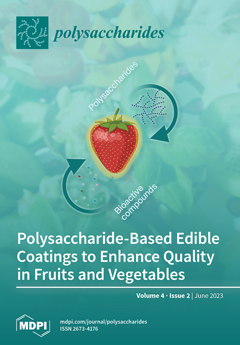The elevation of carbon dioxide (CO
2) levels in the atmosphere is responsible for global warming which in turn causes abrupt climate change and consequently poses a threat to living organisms in the coming years. To reduce CO
2 content in the
[...] Read more.
The elevation of carbon dioxide (CO
2) levels in the atmosphere is responsible for global warming which in turn causes abrupt climate change and consequently poses a threat to living organisms in the coming years. To reduce CO
2 content in the atmosphere CO
2 capture and separation is highly necessary. Among various methods of CO
2 capture post-combustion capture is very much useful because of its operational simplicity and applicability in many industries and power sectors, such as coal-fired power plants. Polymers with high surface area, high volume and narrow pores are ideal solid sorbents for adsorption-driven post-combustion CO
2 capture. Natural polymers, such as polysaccharides are cheap, abundant, and can be modified by various methods to produce porous materials and thus can be effectively utilized for CO
2 capture while the surface area and the pore size of synthetic porous organic polymers can be tuned precisely for high CO
2 capturing capacity. A significant amount of research activities has already been established in this field, especially in the last ten years and are still in progress. In this review, we have introduced the latest developments to the readers about synthetic techniques, post-synthetic modifications and CO
2 capture capacities of various biopolymer-based materials and synthetic porous organic polymers (POPs) published in the last five years (2018–2022). This review will be beneficial to the researchers to design smart polymer-based materials to overcome the existing challenges in carbon capture and storage/sequestration.
Full article





